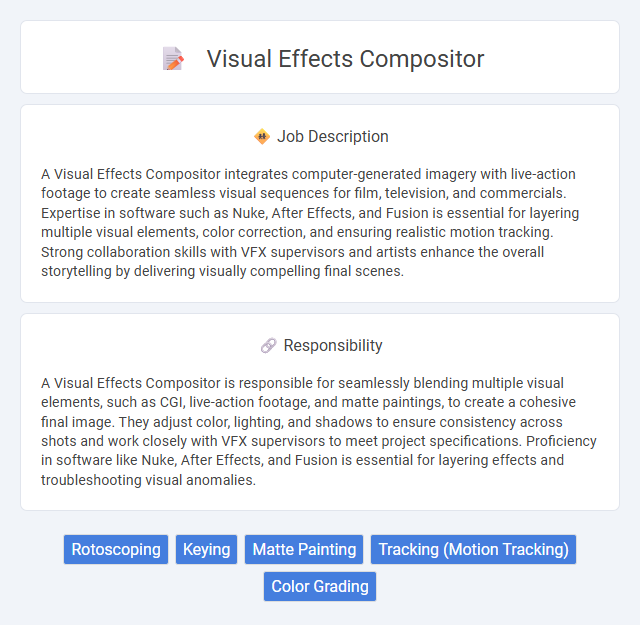
A Visual Effects Compositor integrates computer-generated imagery with live-action footage to create seamless visual sequences for film, television, and commercials. Expertise in software such as Nuke, After Effects, and Fusion is essential for layering multiple visual elements, color correction, and ensuring realistic motion tracking. Strong collaboration skills with VFX supervisors and artists enhance the overall storytelling by delivering visually compelling final scenes.
Visual effects compositor roles may suit individuals with strong attention to detail and a keen eye for visual storytelling, as the job requires blending elements seamlessly in post-production. Those who thrive under tight deadlines and possess a solid understanding of software like Nuke or After Effects might find this career highly fitting. However, people who struggle with long hours or iterative, meticulous work may face challenges adapting to the demands of this profession.
Qualification
A Visual Effects Compositor requires proficiency in industry-standard software such as Nuke, After Effects, and Photoshop, alongside a strong understanding of color theory, lighting, and image composition. Expertise in layering multiple elements to create seamless and photorealistic effects is essential, combined with a solid grasp of compositing techniques like keying, rotoscoping, and tracking. Strong problem-solving skills and a keen eye for detail ensure the final visual effects integrate smoothly into live-action footage, meeting high-quality production standards.
Responsibility
A Visual Effects Compositor is responsible for seamlessly blending multiple visual elements, such as CGI, live-action footage, and matte paintings, to create a cohesive final image. They adjust color, lighting, and shadows to ensure consistency across shots and work closely with VFX supervisors to meet project specifications. Proficiency in software like Nuke, After Effects, and Fusion is essential for layering effects and troubleshooting visual anomalies.
Benefit
Working as a visual effects compositor likely offers the benefit of blending creativity with technical skills, enabling professionals to craft seamless and immersive scenes that enhance storytelling. Opportunities to collaborate with directors and artists may increase the chances of career growth and skill development in cutting-edge software and techniques. The role could also provide job satisfaction through contributing to high-profile projects and seeing the immediate impact of one's work in film and media productions.
Challenge
The role of a visual effects compositor likely involves overcoming complex technical challenges to seamlessly integrate CGI elements with live-action footage. Precision in color grading, layering, and masking may be critical for achieving realistic and immersive scenes. This position probably demands strong problem-solving skills to adapt to evolving software tools and tight production deadlines.
Career Advancement
Visual effects compositors who demonstrate expertise in software such as Nuke, After Effects, and Fusion can quickly advance to senior compositor roles by mastering complex scene layering and integrating CGI with live footage seamlessly. Building strong portfolios with diverse projects and collaborating closely with VFX supervisors enhances opportunities to move into supervisory or pipeline management positions. Continuous learning of emerging technologies like virtual production and real-time rendering drives career growth, making compositors indispensable assets in high-budget film and gaming productions.
Key Terms
Rotoscoping
A Visual Effects Compositor specializing in rotoscoping meticulously isolates elements frame-by-frame to create seamless integrations between live-action footage and digital effects. Expert proficiency in software like Nuke and Silhouette ensures precise matte generation and edge refinement crucial for complex visual storytelling. This role demands exceptional attention to detail and an understanding of motion dynamics to maintain visual consistency across high-resolution film projects.
Keying
A Visual Effects Compositor specializing in Keying expertly isolates and removes green or blue screen backgrounds using advanced software such as Nuke or After Effects. This role requires precision in creating clean, edge-refined mattes to seamlessly integrate visual elements, ensuring realistic final shots. Mastery of keying techniques like pull keying, despill, and edge correction is essential for achieving high-quality composited images.
Matte Painting
A Visual Effects Compositor specializing in Matte Painting integrates digitally created environments with live-action footage to produce seamless scenes in film and television. Mastery of software such as Nuke and Adobe Photoshop is essential for blending layers, adjusting colors, and matching lighting to achieve photorealistic backgrounds. Strong knowledge of perspective, depth, and texture manipulation enhances the overall visual storytelling by creating immersive and believable settings.
Tracking (Motion Tracking)
A Visual Effects Compositor specializing in tracking utilizes advanced motion tracking techniques to seamlessly integrate CGI elements with live-action footage, ensuring precise alignment and natural movement. By analyzing frame-by-frame camera movements and object trajectories, they create accurate tracking data that serves as the foundation for realistic visual effects integration. Mastery of software like Nuke, After Effects, or Mocha Pro enables the compositor to solve complex tracking challenges, enhancing the overall visual narrative.
Color Grading
A Visual Effects Compositor specializing in color grading enhances the final imagery by precisely balancing colors, tones, and contrasts to achieve a cohesive and cinematic look. Mastery of software like DaVinci Resolve, Nuke, and Adobe After Effects is essential for integrating multiple visual elements seamlessly while maintaining color consistency across shots. This role demands a strong understanding of color theory, workflow pipelines, and the ability to collaborate closely with colorists, VFX artists, and directors to ensure the visual narrative aligns with the artistic vision.
 kuljobs.com
kuljobs.com